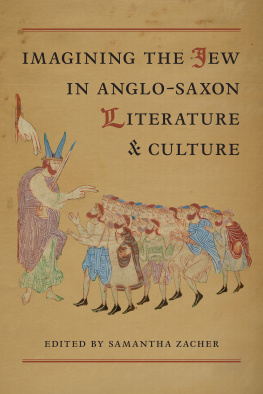Contents
List of Figures
Guide
Pagebreaks of the print version
THE MIDDLE AGES SERIES
Ruth Mazo Karras, Series Editor
Edward Peters, Founding Editor
A complete list of books in the series is available from the publisher.
Englands Jews
Finance, Violence, and the Crown in the Thirteenth Century
John Tolan

UNIVERSITY OF PENNSYLVANIA PRESS
PHILADELPHIA
Copyright 2023 University of Pennsylvania Press
All rights reserved. Except for brief quotations used for purposes of review or scholarly citation, none of this book may be reproduced in any form by any means without written permission from the publisher.
Published by
University of Pennsylvania Press
Philadelphia, Pennsylvania 19104-4112
www.upenn.edu/pennpress
Printed in the United States of America on acid-free paper
10987654321
Hardcover ISBN: 978-1-5128-2389-9
eBook ISBN: 978-1-5128-2400-1
A catalogue record for this book is available from the Library of Congress.
CONTENTS
ACKNOWLEDGMENTS
This book grows out of more than three decades of research in the relations between Jews, Christians, and Muslims in the Middle Ages. In particular, an advanced grant from the European Research Council financed from 2010 to 2015 my research project RELMIN The Legal Status of Religious Minorities in the Euro-Mediterranean World (5th15th centuries) (Under the European Unions Seventh Framework Progamme (FP7/20072013)/ERC grant agreement n249416). The project examined the legal status of religious minorities through a comparative study of legal texts written in Latin, Hebrew, Arabic, Greek, and various European vernaculars. In the course of this project, I became particularly interested in the abundant documentation concerning Jews in England in the thirteenth century. A fellowship from the Herbert Katz Center for Advanced Judaic Studies at the University of Pennsylvania in 2013, on the annual theme Institutionalization, Innovation, and Conflict in 13th-Century Judaism: A Comparative View, allowed me to study the topic in greater detail and launched me on the current project. My special thanks to the fellows and director of the Katz Center for their feedback at the beginning stages of this work, in particular Piero Capelli, Rita Copeland, Kati Inhat, Ephraim Kanarfogel, Sarah Pearce, Marina Rustow, Uri Shachar, and Rebecca Winer.
A number of invitations to discuss my work have provided invaluable occasions to get help and feedback from colleagues. I have presented parts of this research to conferences and seminars at the Institute of Advanced Studies, Jerusalem; Cambridge University; the Arye Maimon-Institut fr Geschichte der Juden, Universitt Trier (where I had the pleasure of being received by the late Alfred Haverkamp, scion of the study of European Jewry in the Middle Ages); the Medieval Seminar of the University of St. Andrews; the Hochschule fr Jdische Studien, Universitt Heidelberg; Nouvelle Gallia Judaica, Montpelier; the Chicago Medieval Studies Workshop; the Institut de Recerca en Identitats i Societats, Universitat de Lleida; Ben-Gurion University of the Negev; University of Leeds; Universit de Strasbourg; University of Pennsylvania; the Centro Inderdisciplinar de Histria, Culturas e Sociedades da Universidade de vora; the Chteau de la Bretesche, Missillac; the sterreichische Akademie der Wissenschaften; and the Center for Medieval Studies at Exeter University. My thanks to those who participated in these events and whose questions and reactions were extremely helpful, in particular to those who invited me: Elisheva Baumgarten, Judah Galinsky, Anna Abulafia, Nora Berend, Robert Bartlett, Johannes Heil, Christoph Cluse, Danile Iancu, David Nirenberg, Flocel Sabat, Chaim Hames, Axel Mller, Lionel Obadia, Anne-Laure Zwilling, Talya Fishman, Clara Almagro, Jenn Jahner, Warren Brown, Claudia Rapp, and Helen Birkett.
I conducted research for this project in libraries in France and the UK. Special thanks to the staff of the Bibliothque Jacques Berque, the Bibliothque universitaire de lUniversit de Nantes, the Bibliothque Nationale de France, the British Library, and the Bodleian Library. In Oxford, my discussions with Paul Brand and Guy Stroumsa helped me greatly in formulating my project. Thanks to the RELMIN project and the Institut du Pluralisme Religieux et de lAthisme, which financed these research trips. In 2016, I benefitted from a fellowship at the Kulturwissenschaftliche Kolleg in Konstanz, as part of a program devoted to religious minorities. Special thanks to Dorothea Weltecke for the invitation, and to my fellow residents, in particular Clara Almagro, Judith Beyer, Stefanie Diekmann, Ana Echevarria, Jean-Paul Ghobrial, Benjamin Scheller, Michelle Szkilnik, and Jack Tannous.
Thanks to Loren Fogle and Philippa Hoskin for sharing their work with me. Thanks to Heather Blurton and Amy Remensnyder for valuable feedback. Thanks to David MacMillan for bringing to my attention the folk song on Little Sir Hugh. Special thanks to those who read a draft of my book and who offered valuable corrections and advice: R. I. Moore, Jen Jahner, David Carpenter, Emily Rose, and Miri Rubin. Thanks also to Jerry Singerman, Ruth Karras, and Jenny Tan for their energy and enthusiasm in making this publication possible, and to the two anonymous readers for University of Pennsylvania Press.
INTRODUCTION
In 2004, workers in Norwich made a macabre discovery: seventeen skeletons in a well shaft. Forensic analysis showed that the bodies, six adults and eleven children aged between two and fifteen, dated from the twelfth or thirteenth century. The adults had been thrown down head first, and the children after them. It is unclear whether they were dead or alive when they were tossed into the well. DNA sequencing suggested that a number of the persons were closely related to each other, and that some elements in their DNA were close to those of Ashkenazi Jews. While there is still uncertainty as to the identity of these people and the circumstances of their death, it seems that these were local Norwich Jews whose bodies were summarily disposed of by their Christian persecutors. The team of forensic pathologists and archaeologists who worked on the case and an episode devoted to it on BBCs History Cold Case brought it to the awareness of a broad public in Norwich and throughout the United Kingdom.
Norwich citizens interviewed in the BBC program expressed shock that their city had been the theatre of anti-Jewish violence. Few were aware of the presence of Jews in thirteenth-century Norwich and the key role they played in the economy of what was then Englands second largest city, a thriving port and trading center. Nor were they aware of the sporadic hostility and violence Norwich Jews faced. It is in Norwich, in 1144, that Jews were first accused of murdering a Christian child, a charge subsequently used to justify extortion and violence against Jews in England and throughout Europe. I will often evoke Norwich in the pages of this book, both as the site of a flourishing Jewish community and as a locus of anti-Jewish violence. Jews, though numerically a small part of the population, played a big role in the history of twelfth- and thirteenth-century Norwich.
Whatever the truth may be behind the Norwich skeletons, their discovery and subsequent publicity shed light on the extent to which the English (like many others) are blind to their own history. Over the past several decades, historians of England and other European colonial powers have emphasized the extent to which the money and labor of slaves and colonial subjects helped drive economic growth and finance the building of key European institutions. Imperial capitals like eighteenth- to nineteenth-century London or Paris were built on the profits of empire: their universities formed colonial elites and their museums showcased colonial booty. Yet nationalist historiographies of the nineteenth and early twentieth centuries rarely acknowledged these facts, preferring narratives celebrating the achievements of the nation and downplaying the importance of slavery and imperialism. Historians who did take an interest in slavery often denounced it as an aberration and celebrated the enlightened Englishmen who fought to abolish it, minimizing the role of slaves and former slaves in the fight against slavery.











